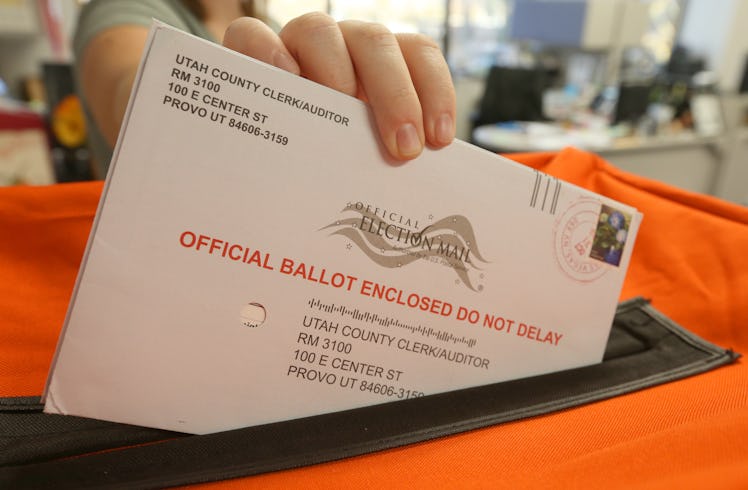
Here's What To Know About Voting By Mail During The Coronavirus Pandemic
There's never a good time for a pandemic, but combining a contagious disease and an election season is particularly rough. As the 2020 presidential election cycle continues, voters and officials are concerned with how to conduct elections while keeping people safe, and in some places, it hasn't gone well. One option that has been widely discussed is whether you can vote by mail during the coronavirus pandemic? You might just be able to.
The question of whether you can vote by mail in the 2020 election is increasingly urgent, as demonstrated in Wisconsin earlier this month. On April 8, Wisconsin held an in-person primary election despite concern about the spread of coronavirus in crowded public places, and even after other states delayed their own primary elections. The decision came after the Supreme Court rejected a request to give voters extra time to return mail-in ballots, forcing many voters to wait in line at crowded polling places to cast their vote. Many voters who requested mail-in ballots also reported not receiving them in time, or submitting them but not having them counted due to controversial rules about witness signatures.
Now, given the social distancing measures recommended by the Centers for Disease Control and Prevention (CDC), a growing number of elected officials are calling for an election that is entirely vote-by-mail, but TIME reported that there are still barriers to such an effort. According to The Washington Post, the obstacles to universal vote-by-mail include the high costs of ballot-counting equipment, changes in staffing and training for poll workers, voter outreach, potential impersonations, and delayed results.
As of April 18, the rules for mail-in ballots differ from state to state. Some states permit voters to request an absentee, or mail-in, ballot without an justification, while others require voters to submit a reason they won't be able to vote on Election Day. On the other hand, five states — Colorado, Hawaii, Oregon, Utah and Washington — use a model that automatically delivers mail-in ballots to active registered voters in every election.
Besides the states that have a full vote-by-mail model, six additional states — Arizona, California, Montana, Nevada, New Jersey, and Virginia — have a permanent absentee status model, in which voters can submit a one-time request to automatically get a mail-in ballot during every election cycle. California is currently working toward the statewide model, and according to the NPR-member radio station KQED, 75% of California's registered voters received a vote-by-mail ballot ahead of the state's March 3 primary election. The vast majority of states, however, require voters to submit a request for a new absentee ballot every time an election comes around. 15 states also require that voters submit an excuse for requesting a mail-in ballot, though seven of these states waive this requirement for voters older than a certain age.
If your state allows you to cast a ballot by mail, you should go to USA.gov to find your state's elections authority and learn how to request your ballot, as well as how to return it, general information about absentee voting, and important deadlines.
According to The New York Times, as of April 14, 16 states and one territory have either delayed their primaries or transitioned to a vote-by-mail model with extended deadlines. Alaska's primary on April 10 was entirely vote-by-mail, and Wyoming and Hawaii will also be voting completely by mail. Meanwhile, the states and territories that have postponed their primaries due to the pandemic include Ohio, Connecticut, Delaware, Indiana, Maryland, Pennsylvania, Rhode Island, Georgia, West Virginia, Kentucky, New York, New Jersey, Louisiana, and Puerto Rico. The Democratic National Convention was also postponed, and is now scheduled to take place the week of Aug. 17.
Many welcomed these delays and changes in primary elections as an effort to keep voters safe, but these changes have also generated concern that the November presidential election will be delayed or even canceled as well. According to Vox, President Donald Trump will not be able to do this without Congressional lawmakers' consent — and with Democrats controlling the House, he is unlikely to achieve this.
Meanwhile, some big names are advocating for better vote-by-mail opportunities. On April 13, former first lady Michelle Obama announced a new vote-by-mail initiative in order to making absentee voting more accessible. Obama launched the initiative through her nonpartisan voter participation group When We All Vote, and according to The Guardian, the group reportedly plans to push lawmakers to extend ballot submission deadlines and make vote-by-mail simpler.
“We know that barriers to voting existed before this crisis, especially for young people and communities of color,” Obama said in a statement, per The Guardian. “Expanding access to vote-by-mail, online voter registration and early voting are critical steps for this moment — and they’re long overdue."
Vote-by-mail laws will not change overnight, but if your state has yet to hold its 2020 primary, make sure to check with your local elections commission to find out whether or not you can vote by mail.
Your voice matters. So does your vote. Make sure both are heard and counted in the 2020 election by registering to vote right now.
If you think you’re showing symptoms of coronavirus, which include fever, shortness of breath, and cough, call your doctor before going to get tested. If you’re anxious about the virus’s spread in your community, visit the CDC for up-to-date information and resources, or seek out mental health support. You can find all Elite Daily's coverage of coronavirus here.